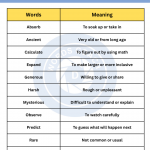Explanatory Linkers in English Grammar
Explanatory linkers are words or phrases that are used to explain or clarify something. They can be used to add information, provide examples, or give reasons.
Some common explanatory linkers include:
- For example: This is a common way to introduce an example.
- To illustrate: This is another way to introduce an example.
- In other words: This is used to provide a different way of saying something.
- That is: This is also used to provide a different way of saying something.
- Specifically: This is used to be more specific about something.
- In particular: This is also used to be more specific about something.
- To be clear: This is used to clarify something that has been said.
- To put it another way: This is another way to clarify something that has been said.
- As I mentioned earlier: This is used to refer back to something that has been said previously.
- As you know: This is used to assume that the reader or listener already knows something.
These are just a few examples of explanatory linkers. There are many other explanatory linkers that can be used in English.
The Role of Explanatory Linkers
Explanatory linkers, also known as transitional words or phrases, play several crucial roles in writing:
- Clarification: They help clarify your ideas and provide further details, ensuring your readers can grasp the full picture.
- Coherence: They improve the logical flow of your text, making it easier for readers to follow your thought process.
- Expansion: They allow you to expand on your ideas and provide in-depth explanations.
- Engagement: By using explanatory linkers, you can engage your audience and make your writing more informative and interesting.
Now, let’s delve into a comprehensive list of explanatory linkers that can elevate your writing.
Explanatory Linkers
Adding Information:
- Furthermore: “The report highlights the environmental benefits of recycling; furthermore, it discusses the economic advantages.”
- Moreover: “The new software update not only enhances security but also improves user experience; moreover, it’s free to download.”
- In addition: “She excels in academics, sports, and extracurricular activities. In addition, she volunteers in her community.”
- Additionally: “Additionally, we found that customer satisfaction has increased since we implemented the new policy.”
- Besides: “Besides the main tourist attractions, there are many hidden gems waiting to be discovered.”
Providing Examples:
- For instance: “Many countries have adopted renewable energy sources, for instance, solar and wind power.”
- Such as: “The menu offers a variety of dishes, such as sushi, pasta, and burgers.”
- Including: “The team includes experts from various fields, including marketing, engineering, and finance.”
- Like: “His paintings are characterized by vibrant colors and bold strokes, like those of famous artists.”
Offering Clarification:
- In other words: “She completed her tasks ahead of schedule, in other words, she finished them earlier than expected.”
- To put it differently: “To put it differently, the project requires a different approach.”
- That is to say: “The company’s profits have soared, that is to say, they have significantly increased.”
Providing Reasons:
- Because of this: “Because of this, we decided to revise our marketing strategy.”
- Due to: “Due to unforeseen circumstances, the event has been postponed.”
- Owing to: “Owing to the team’s dedication, we achieved our sales target.”
- As a result of: “As a result of the merger, the company expanded its market presence.”
Giving Emphasis:
- Indeed: “Indeed, this discovery marks a significant breakthrough in science.”
- Certainly: “Certainly, this new policy will benefit our employees.”
- Without a doubt: “Without a doubt, this is the most challenging project we’ve undertaken.”
Offering Alternatives:
- Alternatively: “Alternatively, you can choose to take the train instead of driving.”
- Or else: “You need to complete the assignment by tomorrow, or else there will be consequences.”
- Otherwise: “You should arrive early; otherwise, you might miss the opening ceremony.”
Summarizing:
- In summary: “In summary, the research findings support our hypothesis.”
- To sum up: “To sum up, the key takeaways from the conference were inspiring.”
- To conclude: “To conclude, the team’s hard work resulted in a successful product launch.”
The best way to learn how to use explanatory linkers effectively is to practice using them in your own writing. Pay attention to the way that explanatory linkers are used in the writing that you read, and try to imitate the way that they are used.
Here are some tips for using explanatory linkers effectively:
- Use explanatory linkers sparingly. You don’t want to overuse them, or your writing will become repetitive.
- Choose the right explanatory linker for the relationship you are trying to show.
For example, if you are providing an example, you would use an explanatory linker of example. If you are clarifying something, you would use an explanatory linker of clarification. - Place the explanatory linker in the right place in the sentence. The explanatory linker should usually come between the two clauses or sentences that it is connecting.
By following these tips, you can use explanatory linkers to improve your writing.
I hope this helps!




